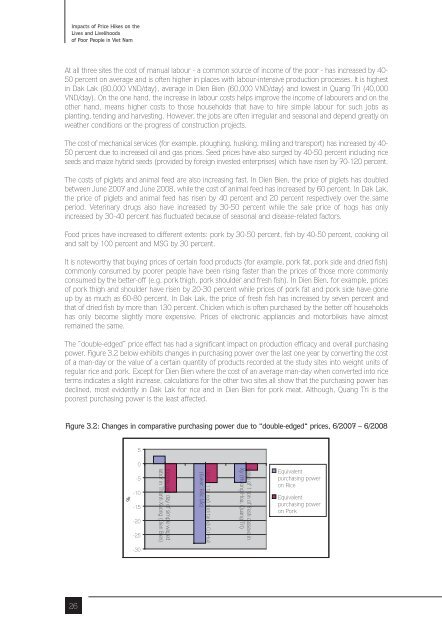Untitled - Oxfam Blogs
Untitled - Oxfam Blogs
Untitled - Oxfam Blogs
You also want an ePaper? Increase the reach of your titles
YUMPU automatically turns print PDFs into web optimized ePapers that Google loves.
Impacts of Price Hikes on the<br />
Lives and Livelihoods<br />
of Poor People in Viet Nam<br />
At all three sites the cost of manual labour - a common source of income of the poor - has increased by 40-<br />
50 percent on average and is often higher in places with labour-intensive production processes. It is highest<br />
in Dak Lak (80,000 VND/day), average in Dien Bien (60,000 VND/day) and lowest in Quang Tri (40,000<br />
VND/day). On the one hand, the increase in labour costs helps improve the income of labourers and on the<br />
other hand, means higher costs to those households that have to hire simple labour for such jobs as<br />
planting, tending and harvesting. However, the jobs are often irregular and seasonal and depend greatly on<br />
weather conditions or the progress of construction projects.<br />
The cost of mechanical services (for example, ploughing, husking, milling and transport) has increased by 40-<br />
50 percent due to increased oil and gas prices. Seed prices have also surged by 40-50 percent including rice<br />
seeds and maize hybrid seeds (provided by foreign invested enterprises) which have risen by 70-120 percent.<br />
The costs of piglets and animal feed are also increasing fast. In Dien Bien, the price of piglets has doubled<br />
between June 2007 and June 2008, while the cost of animal feed has increased by 60 percent. In Dak Lak,<br />
the price of piglets and animal feed has risen by 40 percent and 20 percent respectively over the same<br />
period. Veterinary drugs also have increased by 30-50 percent while the sale price of hogs has only<br />
increased by 30-40 percent has fluctuated because of seasonal and disease-related factors.<br />
Food prices have increased to different extents: pork by 30-50 percent, fish by 40-50 percent, cooking oil<br />
and salt by 100 percent and MSG by 30 percent.<br />
It is noteworthy that buying prices of certain food products (for example, pork fat, pork side and dried fish)<br />
commonly consumed by poorer people have been rising faster than the prices of those more commonly<br />
consumed by the better-off (e.g. pork thigh, pork shoulder and fresh fish). In Dien Bien, for example, prices<br />
of pork thigh and shoulder have risen by 20-30 percent while prices of pork fat and pork side have gone<br />
up by as much as 60-80 percent. In Dak Lak, the price of fresh fish has increased by seven percent and<br />
that of dried fish by more than 130 percent. Chicken which is often purchased by the better off households<br />
has only become slightly more expensive. Prices of electronic appliances and motorbikes have almost<br />
remained the same.<br />
The “double-edged” price effect has had a significant impact on production efficacy and overall purchasing<br />
power. Figure 3.2 below exhibits changes in purchasing power over the last one year by converting the cost<br />
of a man-day or the value of a certain quantity of products recorded at the study sites into weight units of<br />
regular rice and pork. Except for Dien Bien where the cost of an average man-day when converted into rice<br />
terms indicates a slight increase, calculations for the other two sites all show that the purchasing power has<br />
declined, most evidently in Dak Lak for rice and in Dien Bien for pork meat. Although, Quang Tri is the<br />
poorest purchasing power is the least affected.<br />
Figure 3.2: Changes in comparative purchasing power due to “double-edged“ prices, 6/2007 – 6/2008<br />
5<br />
%<br />
0<br />
-5<br />
-10<br />
-15<br />
-20<br />
-25<br />
Income per day of simple waged<br />
labor in Thanh Xuong (Dien Bien)<br />
Giá trị 1 tạ ngô tươi tại xã Cư Huê<br />
(Eakar, Đắc Lắc)<br />
Value of 1 ton of fresh cassava in<br />
Xy (Huong Hoa, Quang Tri)<br />
Equivalent<br />
purchasing power<br />
on Rice<br />
Equivalent<br />
purchasing power<br />
on Pork<br />
-30<br />
26

















